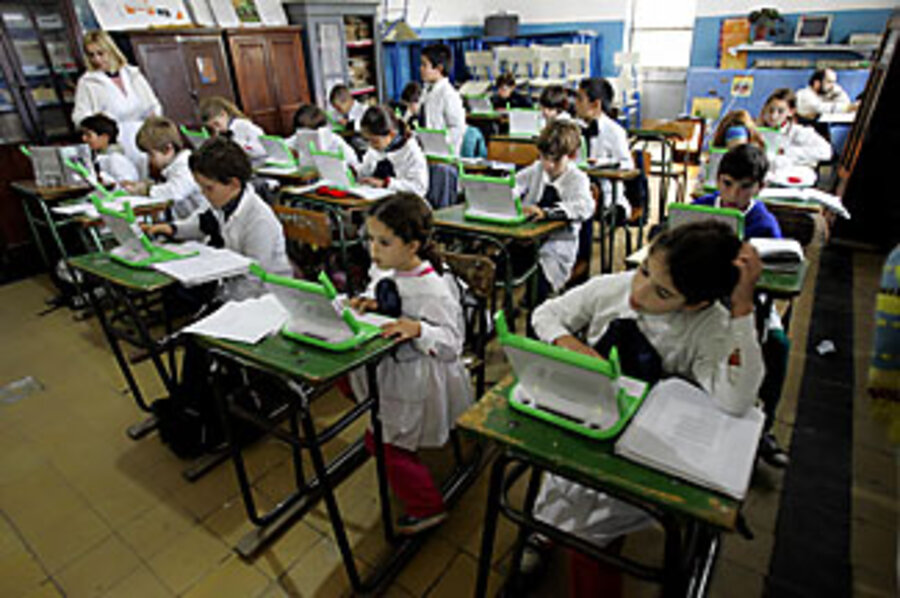More computer brands chase the '$100 laptop'
Loading...
The laptop computers most people haul around are underutilized. They hardly break a sweat to read e-mail, stream video, view photos, browse the Web, or run word-processing or spreadsheet programs. Their powerful processors are rarely tested except by heavy-duty gamers, scientific researchers, or other specialized users.
So while some PCs continue to bulk up and tout their speed and raw power, others represent a new trend: slimming down. Way down. These smaller, simpler machines are aimed at a potentially lucrative market: the next 1 billion PC users around the planet.
The market segment is so new it doesn't have a name yet or even an agreed-upon set of specifications. Intel, the chipmaker, calls the category "netbooks," recognizing that much of what people do on their laptops involves going on the Net. The new machines are also being called ultra-low-cost PCs, mininotebooks, or even mobile Internet gadgets.
In appearance, they have the familiar clamshell design, but they're smaller, with seven- to 10-inch screens. They offer full keyboards (albeit with smaller keys) and weigh less than three pounds. Perhaps most important, the majority cost less than $500 – some as little as $299.
Intel says it expects more than 50 million of these netbooks to be sold by 2011. It's introduced a tiny, low-power processor to run them called Atom, which puts 47 million transistors on a chip about the size of a penny.
Seventy to 80 percent of tasks people do on computers today are online, says Uday Marty, the marketing director for Intel's netbook products. Intel has created the Classmate PC to show the potential market for students around the world. In Brazil, they're sold under the Postivo brand. In India, Intel partners with HCL Infosystems to produce them.
The Taiwanese computermaker Asus burst out of the gate last fall with its Eee PC, priced at $299 (with the Linux operating system) and $399 (with Windows XP). Hewlett-Packard, Dell, Acer, and others have similar machines in the works.
"There's a lot of potential for these products," says Michael Gartenberg, vice president and research director at Jupiter Research in New York. Ultraportable computers have been around for more than a decade, he says. What's new is the low price, making them "attractive as perhaps a second or third computer for a household, or a primary computer for a student."
They represent the idea of the "ubiquitous computer – the computer that you can have with you at all times," he says. These micro-PCs are more likely to eat into laptop sales than threaten even-smaller hand-held devices, phones with extra features such as Web-browsing, Mr. Gartenberg says.
For one thing, the minilaptops have battery lives of only a few hours, not days, making them not yet ready to be "always on" companions.
"I really think the unknown dynamic is what happens when these $200 to $300 netbooks are unleashed in India and China and Indonesia," said Paul Otellini, president and CEO of Intel, in a conference call to industry analysts on April 15. "And we don't [know]. There is no model for that at this point in time because you are dealing with something that's never existed before."
The tiny laptops, some roughly the size of a large paperback book, are far too large for a pants pocket, but could easily fit inside a purse. The smaller keyboards may work well for children. Many run on an operating system called Linux, favored by the technorati but little known among most computer users. Those that include Microsoft's familiar Windows usually cost a bit more. Microsoft has said it will continue to allow manufacturers to sell its older Windows XP system in the minilaptops, saving on both cost and system operating requirements over the newer Windows Vista.
The nonprofit model
These for-profit ventures follow in the footsteps of the nonprofit One Laptop Per Child (OLPC) project in Cambridge, Mass. Many were skeptical when OLPC announced several years ago that it would develop and distribute small laptops to children across the developing world for $100 each.
In recent months several top executives have stepped down from OLPC, leaving some critics to wonder if its mission is still viable.
While OLPC hasn't reached its original aim of $100 PCs, it is selling its tiny laptop, called the XO, for $189, still lower than the for-profit ventures. That price includes some special educational features and software developed by OLPC for the Linux OS.
Nicholas Negroponte, founder and chairman of OLPC, says that the XO is already Windows capable and he expects it to include a version of Microsoft's operating system in the future. He hopes the new for-profit competition will spur manufacturers to develop better technologies and drive costs even lower.
About 500,000 of the rugged, kid-friendly XO laptops have been ordered so far, with the majority already built and shipped, Mr. Negroponte says.
OLPC has seen Intel, which in January withdrew as a partner in the OLPC project, and other computer companies begin to compete for student markets in the developing world. Sometimes these companies are "dumping" their products at low prices to try to shut out OLPC, Negroponte said in late April. "Last week Asus tried that trick in Turkey," he said.
OLPC is a humanitarian effort, not a business, Negroponte says. He likens the OLPC to the World Food Program, which does not try to compete with McDonald's. "I don't want to compete with anyone," he says.
How low can prices go? OLPC is aiming for a 2.0 version of the XO that will cost only $50, Negroponte says. But don't expect that until late 2010.
Clever solution: 'dumb' computers
Meanwhile Ncomputing in Redwood City, Calif., may be the current price leader for student sales, although its product isn't a laptop. The company's device connects "dumb" terminals to a central computer. That core machine then shares its processing power with each of the networked computers.
This idea of "desktop virtualization" is not new. But what's changed is the mushrooming power of even a single PC. One bottom-of-the-line $350 desktop can act as a server for a half-dozen workstations, or more, at a cost as low as $70 per terminal, says Stephen Dukker, CEO of NComputing. And each student gets his or her own keyboard, mouse, and monitor.
Ncomputing has sold 600,000 of its devices already, says Mr. Dukker. The largest buyer has been the country of Macedonia, which bought 180,000 units for its schoolchildren. The company also has made sales in Malaysia, Indonesia, India, Brazil, and a few African countries.
The "dumb" devices use only about 1 watt of power each, he says, compared with many times that much for PCs. That can be especially important in remote areas where electricity is at a premium.
The costs of maintenance and replacement are lower, too, since when a single computer is replaced or repaired it automatically upgrades or restores all the workstations attached to it.
The workstations can't be taken home by students, as with laptops, but that also means that the school's computers are less likely to be stolen or damaged, Dukker says.
"Our technology represents the beginning of the end of [cost] barriers to access to computing," he says.






